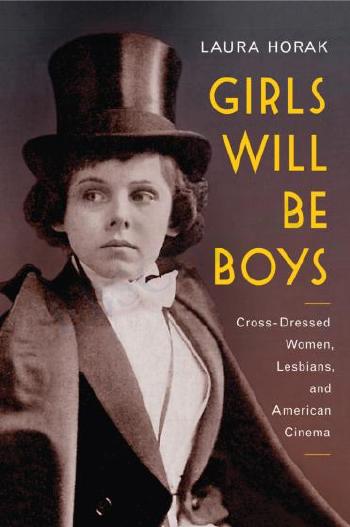Girls Will Be Boys: Cross-Dressed Women, Lesbians, and American Cinema, 1908-1934 by Laura Horak

Author:Laura Horak [Horak, Laura]
Language: eng
Format: azw3, pdf
Tags: PER004030 Performing Arts / Film & Video / History & Criticism
ISBN: 9780813574844
Publisher: Rutgers University Press
Published: 2016-02-25T16:00:00+00:00
The Well of Loneliness and the Lesbian Books of 1928
At the same time that The Captive was playing around the country, a host of novels treating lesbianism and inversion were published in the United States and England. These included Warner Fabian’s Unforbidden Fruit, Wanda Fraiken Neff’s We Sing Diana, Compton Mackenzie’s Extraordinary Women, Virginia Woolf’s Orlando, Djuna Barnes’s Ladies Almanack, and Radclyffe Hall’s The Well of Loneliness. Some were intended for a small circle of readers already in the know, but others aimed to reach the general public. The books ensured that lesbianism and inversion stayed in the public consciousness even as The Captive disappeared from American stages. By far the most discussed of the bunch, Radclyffe Hall’s Well of Loneliness promoted a model of the invert that would have important repercussions for cross-dressing in moving pictures, as we will see in the next chapter.
Before Well came the trashy Unforbidden Fruit and sedate We Sing Diana, both about life in women’s colleges. The two books were aimed at a mass market: Unforbidden Fruit cost $2.00 and We Sing Diana $2.50. Educators had begun to view relationships between girls at women’s colleges as potentially pathological, rather than a normal part of female development.163 When it became clear in February 1927 that Liveright would not be able to remount The Captive in New York, he announced that a “study of attachments between girls at Radcliffe, Vassar, Wellesley and other women’s colleges has been made by Warner Fabian, who wrote ‘Flaming Youth’ four years ago. . . . It deals with the same theme in a novel as ‘The Captive’ does on the stage.”164 Smart Set printed the first five chapters of Fabian’s novel between February and June 1928, and in July, Boni & Liveright published the book. Fabian’s novels were famed for capturing the devil-may-care attitude of modern girls, and Unforbidden Fruit was no different. However, despite Liveright’s declaration, the Captive theme was only peripheral. On three brief occasions, the protagonists mention a girl who takes men’s roles in campus plays, sings double-alto in the glee club, and shows untoward interest in a freshman girl.165 However, we never see this girl directly, nor does anything happen between her and another girl.
Houghton Mifflin published Wanda Fraiken Neff’s We Sing Diana in February 1928. In contrast to the nonstop partying in Fabian’s novel, We Sing Diana shows women’s communities as sterile and stifling, but the book takes a similar attitude toward lesbian activity. The narrator, a student at an East Coast women’s college, observes, “Intimacies between girls were watched with keen, distrustful eyes. Among one’s classmates, one looked for the bisexual type, the masculine girl searching for a feminine counterpart, and one ridiculed their devotions.”166 (At this time, “bisexual” usually meant possessing two sexes, as mentioned in chapter 3.) These intimacies remained firmly at the margins of the story, and one female book critic even complained that “Mrs. Neff touches only superficially the inescapable problem of perversion.”167 Both novels adhered to a model of gender inversion.
Download
Girls Will Be Boys: Cross-Dressed Women, Lesbians, and American Cinema, 1908-1934 by Laura Horak.pdf
This site does not store any files on its server. We only index and link to content provided by other sites. Please contact the content providers to delete copyright contents if any and email us, we'll remove relevant links or contents immediately.
| African-American Studies | Asian American Studies |
| Disabled | Ethnic Studies |
| Hispanic American Studies | LGBT |
| Minority Studies | Native American Studies |
Cecilia; Or, Memoirs of an Heiress — Volume 1 by Fanny Burney(32434)
Cecilia; Or, Memoirs of an Heiress — Volume 2 by Fanny Burney(31868)
Cecilia; Or, Memoirs of an Heiress — Volume 3 by Fanny Burney(31852)
The Great Music City by Andrea Baker(31327)
We're Going to Need More Wine by Gabrielle Union(18967)
All the Missing Girls by Megan Miranda(15561)
Pimp by Iceberg Slim(14378)
Bombshells: Glamour Girls of a Lifetime by Sullivan Steve(13971)
Talking to Strangers by Malcolm Gladwell(13219)
Norse Mythology by Gaiman Neil(13204)
Fifty Shades Freed by E L James(13157)
For the Love of Europe by Rick Steves(12920)
Mindhunter: Inside the FBI's Elite Serial Crime Unit by John E. Douglas & Mark Olshaker(9186)
Crazy Rich Asians by Kevin Kwan(9165)
The Lost Art of Listening by Michael P. Nichols(7403)
Enlightenment Now: The Case for Reason, Science, Humanism, and Progress by Steven Pinker(7228)
The Four Agreements by Don Miguel Ruiz(6618)
Bad Blood by John Carreyrou(6543)
Weapons of Math Destruction by Cathy O'Neil(6139)
